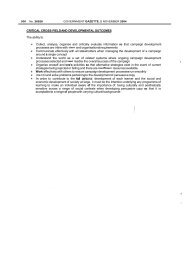Macroeconomic strategies, agriculture and rural poverty in post ...
Macroeconomic strategies, agriculture and rural poverty in post ...
Macroeconomic strategies, agriculture and rural poverty in post ...
You also want an ePaper? Increase the reach of your titles
YUMPU automatically turns print PDFs into web optimized ePapers that Google loves.
workers <strong>in</strong> this subsector has <strong>in</strong>creased, or rema<strong>in</strong>ed steady, <strong>in</strong> the face of sharp decl<strong>in</strong>es <strong>in</strong><br />
overall agricultural employment levels. Horticultural farmers employ more labour at higher<br />
wage rates than field crops <strong>and</strong> animal products, the other two ma<strong>in</strong> agricultural sub-sectors<br />
(Abstract, Agricultural Statistics 1995). Indeed, irrigated <strong>agriculture</strong> requires five times more<br />
labour than for field crops (St<strong>and</strong><strong>in</strong>g et al 1996). Citrus farmers currently employ upwards of<br />
100,000 workers (Dixie 1995) <strong>and</strong> employment <strong>in</strong> the deciduous fruit sector is over 330,000<br />
(de Klerk 1996). Many of these farm workers are <strong>rural</strong> women, a category that most <strong>poverty</strong><br />
studies identify as be<strong>in</strong>g the poorest <strong>and</strong> most vulnerable group <strong>in</strong> South Africa. One of the<br />
reasons why employment levels have not decl<strong>in</strong>ed as rapidly is because harvest<strong>in</strong>g, plant<strong>in</strong>g<br />
<strong>and</strong> ma<strong>in</strong>ta<strong>in</strong><strong>in</strong>g horticultural crops is less vulnerable to mechanisation. In contrast, the<br />
impact of mechanisation of field crops like maize, which has been well documented, has had<br />
far reach<strong>in</strong>g impacts on employment structure <strong>and</strong> overall levels of employment (de Klerk<br />
1984; Marcus 1989). Increas<strong>in</strong>g levels of mechanization, particularly <strong>in</strong> the period after the<br />
late 1960s, led to a sharp decrease <strong>in</strong> the overall workforce on maize farms. Casual <strong>and</strong><br />
seasonal workers, most of whom were women, were disproportionately affected by<br />
mechanization: while the numbers of permanent employees decreased by 20%, the number<br />
of casual employees dropped by as much as 50% on some farms. Although the labour<br />
process <strong>in</strong> horticulture is not immune to labour sav<strong>in</strong>g devices, many tasks, notably<br />
harvest<strong>in</strong>g soft <strong>and</strong> easily bruised fruit <strong>and</strong> vegetables, cannot be performed us<strong>in</strong>g a mach<strong>in</strong>e.<br />
S<strong>in</strong>ce export <strong>agriculture</strong> depends on irrigation, production levels - <strong>and</strong> by implication<br />
employment levels - are less vulnerable to periodic droughts which devastate other sectors of<br />
<strong>agriculture</strong>. While the value of maize exports <strong>in</strong> 1994 - a year of exceptionally high ra<strong>in</strong>fall -<br />
was far higher than for all other crops, the value of maize exports varied wildly <strong>in</strong> the period<br />
between 1989 <strong>and</strong> 1994 (Figure 1). Citrus <strong>and</strong> deciduous fruit exports, <strong>in</strong> contrast, were far<br />
more stable <strong>and</strong> both experienced comparatively steady ga<strong>in</strong>s through the 1990s. The<br />
dislocation that farm workers experience when maize <strong>and</strong> other field crops fail due to<br />
drought, is less likely for farm workers on fruit, vegetable <strong>and</strong> citrus farms. The organisation<br />
of fruit, citrus <strong>and</strong> grape product market<strong>in</strong>g also places <strong>in</strong>dustry <strong>in</strong> a strong position to<br />
exp<strong>and</strong> exports. Market<strong>in</strong>g is organised by several large <strong>in</strong>terconnected monopolies which<br />
control the sophisticated <strong>in</strong>frastructure required to transport the crop from the farm to an<br />
overseas supermarket. Although the statutory monopoly these organisations have had over<br />
exports has been questioned or repealed, they have the resources <strong>and</strong> expertise to open new<br />
overseas markets <strong>in</strong> an extremely competitive <strong>in</strong>ternational environment.<br />
9<br />
Figure 1: Value of exports for selected<br />
(constant r<strong>and</strong>s)<br />
1800<br />
1600<br />
1400<br />
1200<br />
1000<br />
800<br />
R<strong>and</strong><br />
600<br />
400<br />
200<br />
0<br />
1989 1990 1991 1992 1993 1994<br />
Maize<br />
Citrus<br />
Deciduous fruit<br />
Year

















